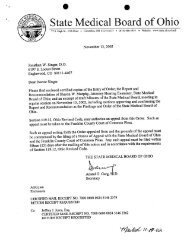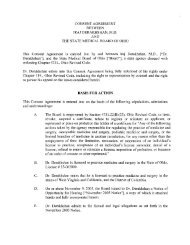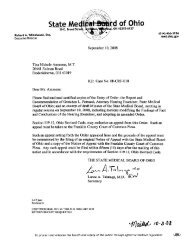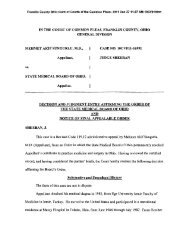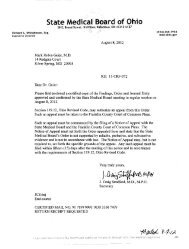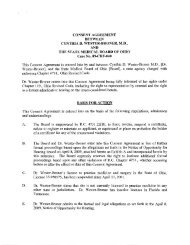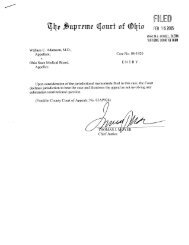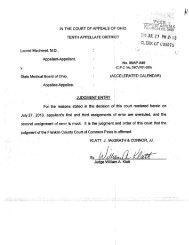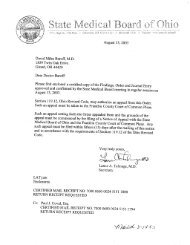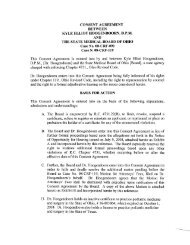Untitled - State Medical Board of Ohio - State of Ohio
Untitled - State Medical Board of Ohio - State of Ohio
Untitled - State Medical Board of Ohio - State of Ohio
You also want an ePaper? Increase the reach of your titles
YUMPU automatically turns print PDFs into web optimized ePapers that Google loves.
Report and Recommendation<br />
In the Matter <strong>of</strong> Jeffrey Vaughn Meyer, M.D.<br />
Page 8<br />
specimen is because the dilution level directly impacts the quantitative amount <strong>of</strong> the drug<br />
in a specimen. A creatinine level <strong>of</strong> 155 milligrams per deciliter is within the normal<br />
range, but a creatinine level <strong>of</strong> 16.7 milligrams per deciliter is abnormally low and<br />
potentially diluted. If the creatinine level is found to be abnormal, B&S will measure the<br />
“specific gravity” <strong>of</strong> the specimen as another means for evaluating dilution. (Tr. at 124-<br />
125, 141-144)<br />
Dr. Closson further explained that B&S’ accuracy rate is 80 percent; or, in other words,<br />
there is a plus or minus 20 percent quantitative variability. (Tr. at 114-115)<br />
17. Upon cross-examination, Dr. Closson noted that B&S uses a single-point calibration<br />
methodology for evaluating the amount <strong>of</strong> a drug in a specimen, which is “the convention”<br />
in the field <strong>of</strong> forensic toxicology. In particular, he stated that multiple-point calibration<br />
* * * to a slight degree [] would enhance the quantitative accuracy. But the<br />
increase in accuracy is not significant when it comes to quantifying the<br />
amount <strong>of</strong> drugs significantly above the cut<strong>of</strong>f level. The importance is to be<br />
able to accurately quantify around the cut<strong>of</strong>f level, and that’s why we use that<br />
single point at that discrimination level <strong>of</strong> 15 nanograms per [milliliter]. * * *<br />
When the amount that you’re measuring is well above the cut<strong>of</strong>f, it still falls<br />
within 20 percent <strong>of</strong> the target concentration, whether you use a single point<br />
or multiple points. Therefore, there’s no real benefit to a laboratory adding<br />
those additional [multiple-point] samples to the analysis.<br />
(Tr. at 136-137)<br />
18. Below is summary <strong>of</strong> B&S’ test results for Dr. Meyer’s urine specimens from September<br />
28 through October 25, 2006:<br />
Date <strong>of</strong> THC Creatinine THC THC GC/MS<br />
Urine Sample EMIT Result Level GC/MS Result Cut<strong>of</strong>f Level<br />
9/28/06 Negative 20.1 mg/dl Negative 15 ng/ml<br />
10/10/06 Positive 155.5 mg/dl 46 ng/ml 15 ng/ml<br />
10/19/06 Negative 53.4 mg/dl Negative 15 ng/ml<br />
10/25/06 Negative 16.7 mg/dl* Negative 15 ng/ml<br />
*Because <strong>of</strong> this below-normal creatinine level, the “specific gravity” <strong>of</strong> this specimen<br />
was measured as another means to evaluate dilution. The “specific gravity” level was<br />
found to be at the low end <strong>of</strong> normal, but within the normal range.<br />
(St. Exs. 3, 4, 6 at 8, 10, 29-32; Tr. at 124-125, 145-146)



